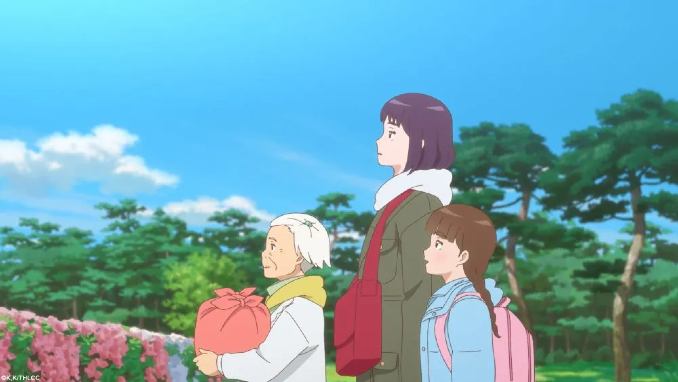Uninspiring Anime The House of the Lost on the Cape Takes on Real Japanese Disaster
Movies Reviews Anime
Shinya Kawatsura’s The House of the Lost on the Cape is a smaller affair than many of the anime films that make it to the big screen here, and it’s an odd bet from distributor Eleven Arts whose catalog of U.S. releases include Japanese box office hits like A Silent Voice or sequel films to popular series like Sword Art Online The Movie: Ordinal Scale or even Shirobako: The Movie. Contrary to those, The House of the Lost on the Cape is a standalone 100-minute feature without much pomp or gravitas. Its themes, subject matter and messages are tempered by uninspiring art direction and a narrative more suited to a visual novel (down to the twinkly acoustic guitar in the soundtrack).
That description alone may excite anime fans, but I don’t suspect The House of the Lost on the Cape to speak to theatergoers that aren’t already subscribed to anime streaming services or don’t even know what a visual novel is. The House of the Lost on the Cape is a didactic text about maintaining community in the face of adversity. Initially released on the 10th anniversary of the events it depicts, it’s set in the aftermath of the 2011 Tohoku earthquake and tsunami and subsequent Fukushima Daiichi nuclear disaster that took the lives of over 19,000, with thousands more injured or still missing. This is a film that—despite its colorful presentation of landscapes drawn right out of a children’s book—wants to say something about Japan and the people who live there.
We meet our trio of protagonists in a shelter some weeks after the earthquake leveled much of their town. Yui (Madeleine Morris), a 17-year-old runaway, and Hiyori (Risa Mei), an eight-year-old orphan, both carrying the weight of traumatic childhoods just before the earthquake upended their lives, are taken into the adoptive care of the elderly Kiwa (Pam Dougherty). She takes them to an enchanted house that (as is explained in one of several beautifully animated shorts that delivers folklore exposition) will provide for them so long as they take care of it.
The overwhelming sentiment of the time and place depicted in The House of the Lost on the Cape is a sort of post-apocalyptic pastoral fantasy. Life is returning to normal, but the rubble remains. There are school buses now, and many missing families. The metaphors that arise when folklore and religious figures suddenly come alive—caring for the land, returning to traditions in times of struggle—are heavy-handed. This, coupled with the simplistic idyll of the setting in the second act, almost suggests a naïve understanding of the nation and community—but there are more teeth to The House of the Lost on the Cape that give its musings on the ideals of the nation after disaster some strength.
An adaptation of Sachiko Kashiwaba’s 2015 novel Misaki no Mayoiga, the imagery of The House of the Lost on the Cape isn’t particularly new. Kashiwaba’s 1987 novel Kiri no Muko no Fushigi na Machi, about a girl’s mystical journey with the spirits of the island nation, was a chief inspiration for Spirited Away. The film invokes spirituality as a sort of shared story for the townspeople, who are able to overcome the ugly, red-eyed horrors of the sea and night by coming together in dance and song and community.
And The House of the Lost on the Cape’s unique focus among other post-3/11 fiction is its depiction of sisters, mothers and matriarchs adjacent to masculinized discourses of patriarchal figures like the father and the nation. Women run the shelter and local government; Kiwa’s unconditional care for the girls is juxtaposed with Yui’s abusive father whom she ran away from; communication with spirits is portrayed as a maternal instinct. The few (human) men who are present mostly just suck, and could be read as representing the patriarchal ills of Japanese society before and after the disaster.
That premise carries thanks to Reiko Yoshida’s screenplay. With her prolific filmography ranging from peak cute-girls-doing-cute things serialized anime like K-On! to heavy-hitting feature-length dramas like the aforementioned A Silent Voice, and credits in everything from Girls und Panzer to Violet Evergarden, she’s perhaps the most uniquely qualified screenwriter to carry a production like this—and her name has appropriately been coupled with Kawatsura’s in Eleven Arts’ marketing of the film.
Other elements of craft are less polished. Both studio and director have limited feature-length experience, which shows in David Production’s animation as an uneven scheme that attempts much and delivers little. Unimpressive 3-D models undercut the sweeping, rotating shots of the house on the cape at the beginning and end of the film, while the vignettes that illustrate the expository folklore are truly interesting experimental works of animation. Much of House of the Lost is composed of uninspiring but passable painterly landscapes with realistic character models, though a handful of photorealistic stills of grassy rivers and quiet city corners genuinely excite.
I’m left feeling ambivalent about The House of the Lost on the Cape. I want there to be room for smaller stories, for anime films to not have to make me cry to get a few screenings in a handful of U.S. theaters, and for the true breadth of the medium to popularize with international audiences. And in that regard, it’s a good one of those, but among post-3/11 works, The House of the Lost on the Cape is stuck still finding its voice. That’s going to be drowned out when Your Name’s journey to the periphery of the nation or Japan Sinks: 2020’s interrogation of home and nationhood have already spoken to us.
Director: Shinya Kawatsura
Writer: Reiko Yoshida
Starring: Mana Ashida, Sari Awano, Risa Mei, Takuya Tasso, Shinobu Ôtake, Pam Dougherty, Madeleine Morris
Release Date: September 7, 2022
Autumn Wright is a freelance games critic and anime journalist. Find their latest writing at @TheAutumnWright.